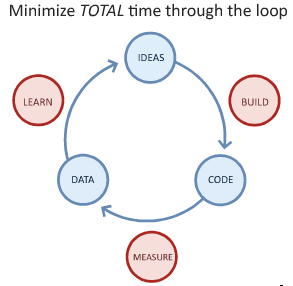A Lean Startup is a startup company that combines Steve Blank’s Customer Development with Agile software development and other techniques that allow the company to iterate quickly to make products or services that customers want and will buy.
 Eric Ries is an entrepreneur and student of Steve Blank, and has written a lot about Lean Startups. Here’s a great presentation about the nuts and bolts of creating a Lean Startup. In particular, one of the main – if not the main focus – of Lean Startups is speed. But a particular kind of speed – speed in learning, building, and measuring. Learning what customers want, building products that meet their needs, and measuring the results… over and over until you have a winning product and a winning way to deliver that product to customers.
Eric Ries is an entrepreneur and student of Steve Blank, and has written a lot about Lean Startups. Here’s a great presentation about the nuts and bolts of creating a Lean Startup. In particular, one of the main – if not the main focus – of Lean Startups is speed. But a particular kind of speed – speed in learning, building, and measuring. Learning what customers want, building products that meet their needs, and measuring the results… over and over until you have a winning product and a winning way to deliver that product to customers.
On slide 24, Eric details a bunch of techniques and tools you can use to iterate faster – this is a great list. At Mifos we do a lot of those things. But I’ve also done a lot of things at other companies, and didn’t end up with truly great results. Why not?
I think at those other companies I was missing two key insights.
One is Blank’s Customer Development, which is a systematic way of breaking down the barriers between the sales, marketing, and product development functions and getting out in the field to learn with customers, enabling the company to find out what customers really want. (To be fair, Ries does list Customer Development, but it’s hidden in the sea of list items.)
The other key insight is increasing iteration speed. I’ve worked on some fast teams. But Eric’s toolbox doesn’t go to the heart of the difference between average teams and great teams. To make an order of magnitude change in speed and quality of the OODA loop, teams need shared vision and good decision making skills.
If team members have the same vision of what they want to achieve, they can trust individuals or subteams to make the right decisions. This saves time because less people have to be involved in each decision, making each decision go faster. On top of that, if the team has a systematic way of making wise decisions swiftly, this will allow them to consistently move at a fast pace.
So how do you get in a state of shared vision and stay there? How do you make wise decisions quickly? Jim and Michele McCarthy take this on in their book Software For Your Head and their Core Protocols methodology. As I detailed in my previous post about Boot Camp, my team at Grameen Foundation recently adopted the Core Protocols with good results. Before the training, our decision-making speed was adequate enough to keep us alive, barely. Afterwards… things are much faster, and speeding up! I’m actually struggling to keep up. I can’t wait to see the results of several months of this pace of work!
And I’m interested to see how combining the Core Protocols with the other Lean Startup techniques works.
One Comment “Lean Startups”